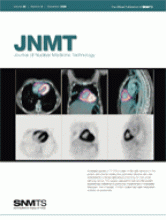Abstract
131I-metaiodobenzylguanidine (MIBG) has been used as a therapeutic agent for pheochromocytoma. Tumor localization and precise staging are essential for therapy with high-dose 131I-MIBG. The sites and extent of 123I-MIBG uptake are usually estimated to predict the effectiveness of therapy before administration. However, conventional scintigraphic images provide insufficient anatomic information. Therefore, we tried to manually superimpose 123I-MIBG SPECT and CT images using free software.
The recent introduction of a hybrid SPECT/CT system has facilitated the process of image fusion (1), but the availability of such specialized equipment is still limited. Therefore, we tried to construct SPECT/CT fusion images without using such equipment (2–6). This study investigated the feasibility and validity of producing SPECT/CT fusion images for accurate localization of metastases from malignant pheochromocytoma.
MATERIALS AND METHODS
This study enrolled 7 patients referred to the Kanazawa University Hospital for therapy with high-dose 131I-metaiodobenzylguanidine (MIBG) for recurrence or metastases from malignant pheochromocytoma (7–9). All patients underwent CT and 123I-MIBG imaging to evaluate the sites and extent of 131I-MIBG uptake. On imaging of CT and scintigraphy, external markers were placed on the same skin surfaces: the center of the sternal notch, the xiphoid process, and bilaterally on the iliac crests (Fig. 1). The markers consisted of 4 small plastic bullets with a diameter of 8 mm, and for SPECT the markers contained 0.3 MBq of 99mTc-pertechnetate. Imaging datasets from the 2 modalities were coregistered and manually superimposed using free software (MRIcro; www.mricro.com) (10).
SPECT images (A, axial; D, sagittal) and CT images (B, axial; E, sagittal) show external markers bilaterally on iliac crests (arrows), sternal notch, and xiphoid process (arrows). In fused images (C, axial; F, sagittal), all CT markers are completely included in SPECT markers, representing good registration.
RESULTS
Table 1 shows the rate of metastasis detection by the different imaging modalities. Overall, 123I-MIBG scintigraphy detected 56 metastatic lesions, comprising 35 in bone, 10 in the chest, and 11 in the abdomen. In patient 1, bone metastasis was overlooked on CT images, despite abnormal uptake at the upper lung level on scintigraphy (Fig. 2). Fused images demonstrated that the site of abnormal uptake corresponded to a metastasis on the T2 vertebra, which was confirmed with MRI. In contrast, CT was superior to scintigraphy in detecting small lesions in the lung field and liver. In our experience, poor registrations occurred more frequently in the lower chest and upper abdomen. Registration of bone lesions was performed correctly because of the limited effect of respiratory movement on those regions.
(A) 123I-MIBG whole-body scintigraphy of 72-y-old woman (left, anterior; right, posterior) shows area (arrow) of abnormally increased tracer uptake at level of upper chest. (B) Axial SPECT image clearly shows increased tracer uptake, but sites were indeterminate because of lack of anatomic structures. (C and D) Axial CT images do not depict any abnormality under routine imaging conditions, with heterogeneous density under optimal window level (arrows). (E) Fused image shows abnormal uptake (arrow) in metastatic T2 vertebra, with good registration.
Detection of Metastases by Different Imaging Modalities in the 7 Patients
DISCUSSION
Compared with hybrid SPECT/CT systems, the procedure in the present study has some advantages. Fusion of images can easily be obtained without such specialized equipment, and the patient's exposure to radiation is reduced. We used the data from CT to construct fusion images, which were used to search for metastases. But, the procedure in the present study has some disadvantages. Manual fusion requires a few minutes for data transfer and processing, and external markers need to be correctly placed on the body surface to avoid misregistration between CT and scintigraphic images.
CONCLUSION
Image fusion was successful, showed the relationship between the structural CT data and the functional SPECT data, and precisely localized metastatic pheochromocytoma.
Footnotes
-
COPYRIGHT © 2008 by the Society of Nuclear Medicine, Inc.
References
- Received for publication February 11, 2008.
- Accepted for publication August 20, 2008.









